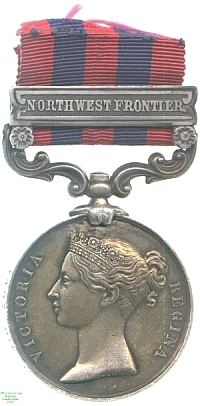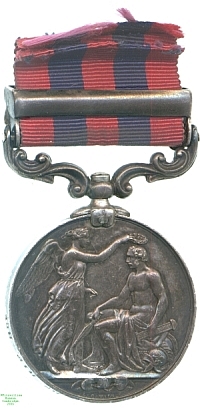
Obverse, a bust of Queen Victoria

Reverse, Victory crowning a seated Classical warrior with a laurel wreath

Obverse, a bust of Queen Victoria |

Reverse, Victory crowning a seated Classical warrior with a laurel wreath |
The Army of India Medal's issue in 1849 having marked the previous half-century's combats in the region, further conflicts in the 1850s led in 1854 to the design and issue of a General Service Medal for the theatre, for which bars would be issued as each new campaign merited.
British India met Afghanistan at the North-West Frontier. Since British influence over Afghanistan competed with the Burmese kingdom of Ava and Russia, the region beyond the frontier, composed of a large number of more-or-less independent tribal statelets, was of great importance to British interests and required continual suppression by `punitive expeditions'. Between 1849 and 1868 16 different minor campaigns were mounted into various areas of the frontier, and in 1869 this bar was issued for the India General Service Medal for participation in any of these expeditions. Some particularly noteworthy engagements were awarded separate bars, and numerous further campaigns followed after 1868, but for these separate bars were usually awarded.
This medal was awarded to Private C. Speed of the 3rd Battalion, Rifle Brigade. The Rifle Brigade were involved in only one of these campaigns, the repulse of an attack by Sultan Muhammad Khan on the fort of Shabqadar around Christmas of 1863, and it was presumably in this battle that Speed won his medal. Lester Watson acquired the medal at some point before 1928.